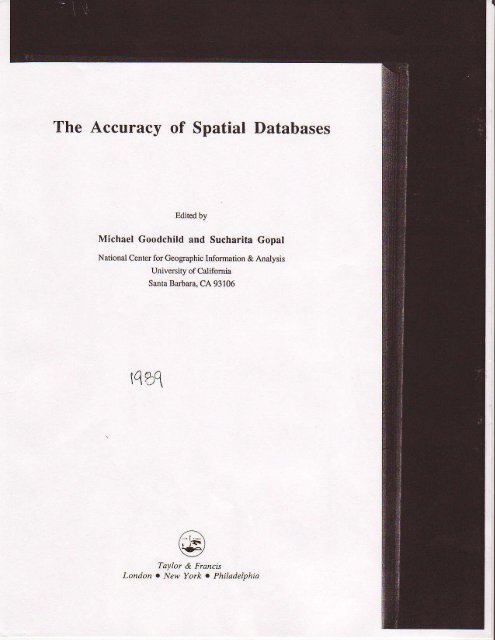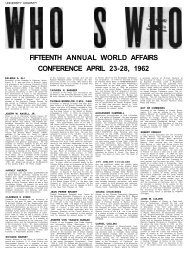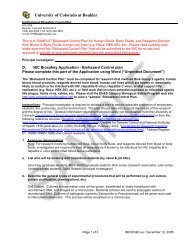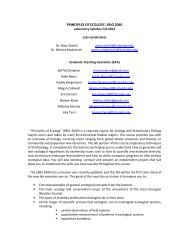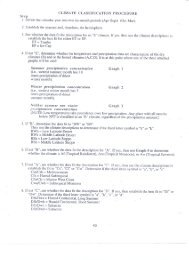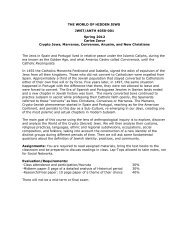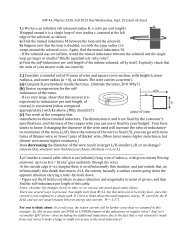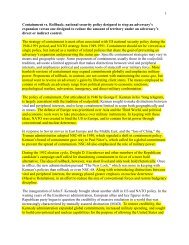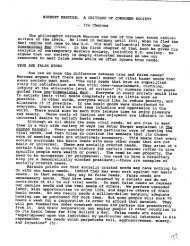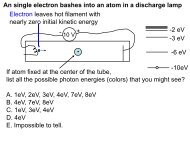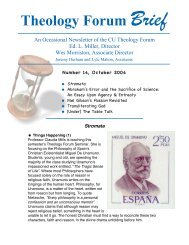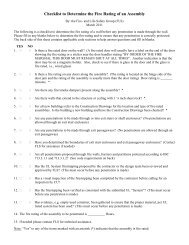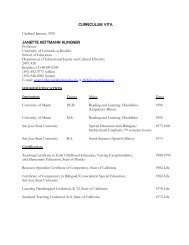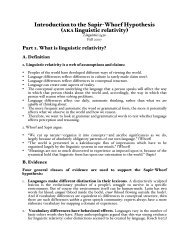goodchild _1989.pdf - University of Colorado Boulder
goodchild _1989.pdf - University of Colorado Boulder
goodchild _1989.pdf - University of Colorado Boulder
You also want an ePaper? Increase the reach of your titles
YUMPU automatically turns print PDFs into web optimized ePapers that Google loves.
The Accuracy <strong>of</strong> Spatial Databases<br />
Edited by<br />
Michael Goodchild and Sucharlta Gopal<br />
Narional Center for Geographic Infonnation & Analysis<br />
<strong>University</strong> <strong>of</strong> California<br />
Sanra Barbara, CA 93 106<br />
t4qq<br />
Taylor & Francis<br />
London . New York . Philadelphia
Chapter 10<br />
Modeling error in objects and fields<br />
Michael F. Goodchild<br />
Introduction<br />
Thc currcnt inr€xEsr in spalial darabases strms ldsely frorn rheiI rolc in suDDonins<br />
geographic informadon syste-ms. and rhe rapidly growing GIS indusny. diss a;<br />
powerful systems for handling sparial data, and in recent ycars they have found<br />
application in fields as different as Eansponadon, foresrry and archaeoi<strong>of</strong>y. Yet the<br />
power <strong>of</strong> a CIS to input, srore, alalyze and output geogaphic information oi all kinds is<br />
at rhe same time a maior liabiliry. To rhe databasc, lhc sEucture used to storc a Dolvson<br />
or pixel has almost no connection !o lhc rcal meaning <strong>of</strong> $e polygon, as a parcel <strong>of</strong> iind,<br />
object on a topographic mapor.stard <strong>of</strong> dmbcr.. The analysl making usc <strong>of</strong> a polygon<br />
oveflay operaEon nas srmlafly utue Fessurc !o De sensrlvc to the tnlerprctation <strong>of</strong>the<br />
data.layers.being overlaid. In realry a_CIS may€ncourage poor analysii by s€paradng<br />
me oara couecEonr comp atron and analysls Nnclons, aod taurng to m8*e $e user aware<br />
<strong>of</strong> rhe.possible dangers <strong>of</strong> indiscriminate use <strong>of</strong> such funcions as scale change,<br />
lecnssll lcanon ano ovcfl av.<br />
Onc <strong>of</strong> thc more bbvious issucs from this persD€ctive is thc existence <strong>of</strong> two<br />
Eaditions <strong>of</strong>CIS analysis. The disrincrion berwcen rasier and veclor is <strong>of</strong>ren seen as a<br />
problem <strong>of</strong> system design. but actually presenls a major issue <strong>of</strong>dala inrc4'reladon. To<br />
emphasize this difference, and to sEess the context <strong>of</strong> data inrerDreErion mther than<br />
system design, we will use the rerms field and object in rhis paper;alrhough rhey are ro<br />
some extenl synonymous with raster and vector respectively. Sotde sDadal databases<br />
represent the world as if it were populaFd by obje.is - poiirs, lines ind areas - with<br />
associated arEibuks. continuing a Eadition developed in cnnography. Orhers reDrcsenr rhe<br />
world as fields. or arrays <strong>of</strong>piiels, again with associated artri--buies'- fie choice bcrween<br />
the two represenhtions has varioDsly b€en seen as depending on lhe method <strong>of</strong> data<br />
collecdon (salellites_generale fields.canogmplers ge-nemre objecrs),_ fie degree <strong>of</strong> sparial<br />
r€solunon requreo (oDjecrs appear ro tmply nlgher tevetS ol spattal rcsolutlon, whereas<br />
pixels imply a lev€l which is fixed by fie pixel size). and rhe efficiency <strong>of</strong> atgorilhrns (for<br />
example, rhe widely held perceprjon thar overlay is faster in nsrer). However we will<br />
argue in !his_paper rhar frelds.and objects represenr fundamenrally differenr tmms <strong>of</strong><br />
aDsracEon or geogmpnrcar reallty.<br />
This paper examines the relarionship between fields and objects ftom the<br />
perspective <strong>of</strong> database error. It is clearly possible o represenr a given ser <strong>of</strong> data in<br />
either [orm. and lo derive one from rhe olh€r by a simp]e CIS operarion such as<br />
rasLer/vector conversion. But conversion must be sensitive lo the nalrie oI Lhe dara and<br />
its uocertainty if subsequent analysis is to be successful.<br />
107
Errors in objects<br />
Goodchild<br />
Consider the comfilon process <strong>of</strong> creating a spatial darabase <strong>of</strong> obiecrs by<br />
digitizing a topographic map. Amibules will tikely be fnrered ftom a keyboird, ani<br />
provided they are keyed correcrly. we can reasonably exped rhem ro be perfeclly<br />
accumle. The localions <strong>of</strong>objects will b€ oblained by digitizing or scanning, and will be<br />
subject to assoned errors. A numb€r <strong>of</strong> factors may connibule lodistonionbfrhe source<br />
docurnenl includirg folding and stretching, changes in humidity, copying processes etc.,<br />
and the process <strong>of</strong> map registradon will inEoduce addirional error Ifdigirizing is used,<br />
posidonal accuracy will be affecred by lhe op€rator's precision in posidoning the cursor,<br />
and by the rules used to select poinrs to be djgirized ftom line or polygon objecrs, whether<br />
in poinr or sEeam mode. Finally rhe positional accuacy <strong>of</strong>a scanncd line will be<br />
affected by the resoludon <strong>of</strong> the scanner.<br />
Of all <strong>of</strong> $ese errors, only cursor positioning has been subject to succsssful<br />
analysis. Keefer, Smith and Gregoire (19E8) have described a model in which each<br />
digitized point on a line or area objecr is disroned ftom irs rrue posidon by a bivadate<br />
disEibudon. Ifeach poinr werc disroned independendy we would reach de rlnreasonable<br />
conclusion rhat the expecled error ar digirized points is greater fian berween dighized<br />
poinrs. bur it is likely thar errors arc posilively correlated bclween adiacenr poinls alone<br />
the digitjzed line. Chrisman and Yandell (1988) a-nd Griffith (rhis volirme) hive obuined<br />
useful esdmates <strong>of</strong> the expected error in polygon area measures based on this type <strong>of</strong><br />
model <strong>of</strong> digitizing enor. However ir is much more diff:cuh !o devise a reasonable model<br />
<strong>of</strong> the process <strong>of</strong> point.selecrion.wbich varies_subslanrially berween digirizer operators<br />
ano rypes or Dnes. and lu(ely conhDutes at leasl as much to error in area esrimates,<br />
Unfonunately any such model woutd have to be sensitive ro the rype <strong>of</strong> line beins<br />
digilized, as meandering rivers clearly presenr very different problems from ropographii<br />
contours or hlghways! whcreas this seems less imponant for modeling cursor positioning<br />
In the cose <strong>of</strong> a counry boundary or the oudine <strong>of</strong> a building, rle darabase obiecr<br />
corresponds directly to a clearly defined objeq in rhe real, geographical world. Buj in<br />
many cases rhe object in the darabase is an absEacr model <strong>of</strong> reat, conrinuous and<br />
compl€x geographic variarion. Althollgh counries and buildines are frequenrly found in<br />
spatial databases, many CIS appljcadons have bcen developed for absrraated obiecrs. In<br />
lhe forest industry, an invenrory <strong>of</strong> foresr resources is co;monly mainrained i; diqital<br />
torm by dividjng the foresr into area objecrs or 'stands" wirh descriprions whictiare<br />
a(ributed homogeneously ro lhe entire stand, In reality the boundaries <strong>of</strong> stands are<br />
tnnsition zones, and the attributgs are heterogeneous, Despite the popularity <strong>of</strong> vecior<br />
dahbases, th€ object model is <strong>of</strong>ten a poor represen ation <strong>of</strong> geognphic vafiad6n.<br />
Crearer difficulty may arise ifrhe artribures assigned ro-an object are rhemselves<br />
abstractions. For exanple the telm ""old growth"" may be attached to a forest stand, but<br />
ambiguities in the definirion <strong>of</strong> old growrh may make it impossible ro rcsolve wherher a<br />
panicula.r point wirhin the srand is or is nol covered by old gowlh. Similarlv ir mav be<br />
necessary to observe a significanr area in order to assign a ilassification suci as a;Den<br />
parkland". l*hich is nor sFictly an arniburc <strong>of</strong> a poinl.bu <strong>of</strong> an exknded area.<br />
Various lerms have been used to disringuish between fie two t)@es <strong>of</strong> error<br />
implied by rhis argumenr. ln lhis paper we use lhe term processing error 16 describe rhe<br />
unce(ajnry inEoduced by digirizing and any subsequenl form <strong>of</strong>digiral processing. such<br />
as veclor/raster converslon. I he terrn source error is used to describe lhe dilferenc€s<br />
whict may exist belween rhe obje(L model and $e geogaphical nuth which it represents.<br />
While source error\ may be absent in represenrarioni <strong>of</strong> counries or buildings,we<br />
conjecture ihal rhey will e\ceed processing errors jn representadons <strong>of</strong>such seocraihical<br />
variares as vegetarion, soil or land use. Since lhe iesutls ot a CtS anaivsi; w t be<br />
interpreted by<br />
cleate the datal<br />
for the field.<br />
MacDougall, 1<br />
The di!<br />
accumcy <strong>of</strong> ml<br />
stand can be ol<br />
is independcnt<br />
estimated by s<br />
will be subject<br />
the arEa within<br />
about hete$ge<br />
Maps (<br />
combines two<br />
point samples<br />
rcmotely senst<br />
field, augmcnl<br />
cleady a derivi<br />
canographer ir<br />
area objects wj<br />
likely vary dei<br />
would-expect i<br />
is difficult to a<br />
acls as a low<br />
convening iror<br />
filter, and sugt<br />
oojects.<br />
Wlilc !<br />
and areas, it I<br />
processing ani<br />
Blakemore(19<br />
a band <strong>of</strong> widd<br />
and source erl<br />
Moreover whil<br />
point in polyl<br />
€sumanng eI'<br />
benchmark GIi<br />
modeling error<br />
Conlou<br />
derived from I<br />
displace it usin<br />
topological in(<br />
derived from z<br />
deriv€d from I<br />
proposidon - t<br />
modeling errot<br />
we explorc this
Eftor in ob|.crs andfeus 109<br />
interFeied by reference to geo$aphic truth rather than to the souce documents used to<br />
deate the dalabase, the existence <strong>of</strong> large source erro$ is a problem <strong>of</strong> major significance<br />
for fie field. Several early papers (see for example McAlpine and Cook, 19?1;<br />
MacDougall, 1975) drcw attendon to the impc'rtance <strong>of</strong> source erors.<br />
The distinction beN€en processing and soulce eftor is critical in cstimating the<br />
accumcy <strong>of</strong> measdrcs derived ftom a database. The eror in the estimated arca <strong>of</strong> a forest<br />
stand c6n be obrained by analyzing the enors introduced in processing its ar€a object, and<br />
is independent <strong>of</strong> source enors implicit in the object. The area <strong>of</strong> a given species can be<br />
esdmated by summing the areas <strong>of</strong>the objects classified as containing rhe species, bu!<br />
will be subject to source errors if the species 4rEibute do€s not apply homogeneously to<br />
the area wirhin each stand. Since an object database comnronly contains no information<br />
about hetoogeneity, it may be difficult or impossible to estimate sou€e enors.<br />
Maps <strong>of</strong> forcst stands or soil rypes are compiled by a complex prccess which<br />
combines two forms <strong>of</strong> dala. Information is first obtaioed on the gound Aom a series <strong>of</strong><br />
point samples or Eansects, and then extended spatially using an aerial phologaph or<br />
remorely sensed scenc. or similar image. Thc area objects are compiled by interpreting a<br />
field, augmenred by point attriburcs, so in rhese eramples $e objecr represenration is<br />
clearly a derivative <strong>of</strong> the field reprcsentation. In compiling the map ftom the image, $e<br />
cartogapher imposcs his or her own oxp€ctations on the data. The boundaries between<br />
area objecrs will be srnoolh genemlizations <strong>of</strong> complex Eansidon zones whose widft will<br />
likely vary depcnding on rhe classes on eirher side. The holes and islands which one<br />
would expect in and around the transition zone will b€ commonly deleted. Finally, in the<br />
case <strong>of</strong> forcst stands thc canographer rnay impose sorne concept <strong>of</strong> minimum size, since it<br />
is difficult to administer stands <strong>of</strong>less than, say, l0 hectarcs. In essence the cartogmpher<br />
acts as a low-pass filter, removing much <strong>of</strong> the detailed g€ographical variation in<br />
convening from field to objects. Unfortunately this removes much <strong>of</strong> the informalion on<br />
which an enor model might b€ based, since enor is selectively deleted by a low-pass<br />
filter, and sugges$ tbat we might focus on mod€ling enoN in fields rather than derivative<br />
oDJCCIS,<br />
Wlile some progress has been made in developing error models for digitizad lines<br />
and areas. it has Droven much morc difficult to construct comDrehensive models <strong>of</strong><br />
processing and s6urce emors for complex geographical objec6. Chrisman (1982),<br />
Blakemore(!984) and others have described the uncenainty in de position <strong>of</strong> a line using<br />
a band <strong>of</strong> $ jd rh e r Perkal, 1956), which is a useful modei<strong>of</strong> cenain kinds <strong>of</strong> processi n !<br />
and source errors but does not deal wilh the problem <strong>of</strong> hetercgeneity <strong>of</strong> arEibutes,<br />
Moreover while the epsilon band can be used to give a probabilistic interprera(ion ro rhe<br />
poinr in polygon operation (Blakemore, 1984) it is not adequate as the basis for<br />
estimating error in area measures, or tor simulating elfor in object databases to<br />
benchmark GIS error propagation. At this point we have no fully satisfactory means <strong>of</strong><br />
modeling enor in complex spatial objects.<br />
Conrours provide another example <strong>of</strong> the difficulty <strong>of</strong> modeling e.ror in objects<br />
derived from fields. A model <strong>of</strong> object distonion mighi lake each contour line and<br />
displace it using a random, aulocorelat€d error process, but it would be easy to prduce<br />
topological inconsistenci€s such as crossinS contours or loops. However contours are<br />
derived fmm an elevatlon field: no matter how elcvations are distoned, the contours<br />
derived from lhem must always be topoloSically consistent. Tlis suggesK a general<br />
proposidon - $ar the solulion lo modeling error in complex spatial objecrs may lie in<br />
modeling elror in the fields ftom which many <strong>of</strong> th€m are obtained. In the next section<br />
we explorc this possibility in more detail.
IIO<br />
Field models <strong>of</strong> enor tn area objects<br />
The previous section concluded with the p.oposition that satisfactory models <strong>of</strong><br />
enor in complex spatial objects could be formulated as models <strong>of</strong> error in fields. In this<br />
section we consider two such models,<br />
Goodchild and Dubuc (1987) proposed a model based on an analogy to the effect<br />
<strong>of</strong>mean annual temperature aid precipitation on life zones. W€ first g€nerate two nndom<br />
fields, using one <strong>of</strong> a number <strong>of</strong> available methods, such as the fractional Brcwnian<br />
prccess, tuming bands or Fourier transforrns (Mandelbmt, 1982). The autocovariance<br />
structur€ <strong>of</strong> th€ fields can be varied to create a mnge <strong>of</strong> surfaces from locally smooth to<br />
localy rugged. Imagine that one fi€ld represents mean annual temperature and the other,<br />
annual DreciDitation.<br />
-Holdridge<br />
etdL (1971) have proposed a simple twodrmensional classifierwhich,<br />
given temperaturc and precipitation, yields the co.responding €cological zone. By<br />
applying such a classifier to the two fields, we obtain a map in which each pixel has been<br />
classified into one <strong>of</strong> the available zon€s. If the pixels are now vectorized into<br />
homogeneous areas, the map salisfies lhe requiremenrs <strong>of</strong>many rypes <strong>of</strong> area class maps:<br />
the space is exhausted by non-overlapping, imegula y shaped area objects, and edges<br />
meet in predominantly three'valent venices. On the other hand if a single field had been<br />
used with a one-dimensional classifier, fte rcsult would have the unmistakable featu&s <strong>of</strong><br />
a contour or isopleth map. To simulate the influence <strong>of</strong> the cartographer, *hich we have<br />
previously compared to the action <strong>of</strong> a low-pass filter, Coodchild and Dubuc (1987)<br />
applied a sptne function ro the vectorized edges, ffd selectively removed small islands.<br />
The model has intcresting properties which it shares with many rcal datasets <strong>of</strong><br />
this class. Because the unde ying fields arc smooth, classes can be adjacent in the<br />
simulated map only ifthey are adjacent in the classifier, so certain adjacencies are much<br />
more common than otheis. The response <strong>of</strong> an edge to a change in one <strong>of</strong> the underlying<br />
fields depends on the geomery <strong>of</strong> the classifiel it is maximum if the corresponding edge<br />
in rhe classifier space is perpendicula.r ro fie appropriare axis, and minimum (zero) ifrhe<br />
edge is parallel to the axis. Sodislonion or error can be simulared by adding distonion ro<br />
the underlying fields.<br />
The model successfully simulates the appearance <strong>of</strong> ajea class maps, and is usgful<br />
in crcating datasets under controlled conditions for use in benchmarking spatial databases<br />
and CIS processes, and for Eacking the propagation <strong>of</strong> enor. On the oder hand tle large<br />
number <strong>of</strong> Darameters in the model make it difficult or imDossible to calibrate asainst real<br />
datasers. P'arameter values would have to be esrablishea for rhe underlying Felds. the<br />
distoning field(s), the classifier, and !h9 spline funcdon used to smooth vectorized edges.<br />
Goodchild and Wang (1988) describe an altemative model based on an analogy lo<br />
remote sensint. Suppose that the process <strong>of</strong> image classification has produced an army<br />
<strong>of</strong>pixels. and that associated with each pixel is a ve.ctor <strong>of</strong> probabilitjes <strong>of</strong>membership in<br />
each <strong>of</strong> the known classes. For example the vector{0.3,0.3.0.4} would indicate<br />
probabilities <strong>of</strong> 0.3,0.3 and 0.4 <strong>of</strong> membership in classes A, B and C respectively. ln<br />
practice we would expect the Foponion <strong>of</strong> non-zero probabilities to be small. allowing<br />
the vectors b be stored efficiently,<br />
We now requir€ 6 process <strong>of</strong> realizing pixel classes such that (l)the probabilities<br />
<strong>of</strong> each class across realizations are as specfied, and (2) spatial d€pendence between<br />
pixels in any one rcalization. The degree <strong>of</strong> spatial depenalence will aletennine the size <strong>of</strong><br />
homog€neous patches which develop. With high spatial d€pend€nce, a giv€n pixel will<br />
belong to large patches in each Ealization: in 30% <strong>of</strong> realizations th€ €xample pixd will<br />
be part <strong>of</strong> a patch <strong>of</strong> class A, 3O% B and 404o C.<br />
Goodchild and Wang (1988) described a simple Focess which satisfies only one<br />
<strong>of</strong> lhe requirements. Initial classes were assigned to each pixel by independent trials, and
y models <strong>of</strong><br />
ields. In this<br />
to the €ffect<br />
aI Brownian<br />
ly smooth to<br />
nd the oth€r,<br />
Eifier which,<br />
tl zone. By<br />
ixel hrs been<br />
torized into<br />
r class rhaps:<br />
s, and edges<br />
eld had been<br />
le fea$rcs <strong>of</strong><br />
ubuc (1987)<br />
all islands.<br />
Ll datasets <strong>of</strong><br />
acent in |he<br />
ies are much<br />
e underlying<br />
|olr(Ung edge<br />
(zero) if the<br />
distortion to<br />
?rnd is useful<br />
ial databas€s<br />
rnd the large<br />
, against rcal<br />
g fields, the<br />
'rized edges.<br />
Ln analogy to<br />
ced an an?y<br />
tmbership in<br />
uld indicate<br />
ectively. In<br />
all, allowing<br />
probabilities<br />
rc the size <strong>of</strong><br />
en pixel wilt<br />
rle pixel will<br />
les only one<br />
nt Eials, and<br />
E.rcr in objecls and fields 1<br />
a 3x3 modal fdler was then passed over Lhe army, reolacins lhe vajue <strong>of</strong>rhe cenE-dl Dixel<br />
by the modai value <strong>of</strong> rhe 3ri window. While tliis ens-ures sDdlial dependence. Lhe<br />
poslenorprobabiliries are nor equal to rhe priors excepr in special iases.<br />
More rec€nrly, we have experiniented witil two merhods *hich saaisfv borh<br />
requirements. In rhe firsr. w€ firsr generarc a lafge number <strong>of</strong> realizarions'usins<br />
lndepenclent. trl al s. On each simulared map. w€ counr lhe numbfr <strong>of</strong> 4-adjacenciei<br />
oerween u
112 GoodcNld<br />
Discussion<br />
. The_process by wbich a spatia.l dahbas€ is crealed ftom a sourcc map is comDlex.<br />
ano error-ol_vanous types is introduced at each slep. Some <strong>of</strong>$e ermr corioonenti can<br />
De mooeted,. and progress has been made in analyzing the errors dui to cursor<br />
pos ronlng.. Dur others such as point selecrion are more difficuh, and rhe eoal <strong>of</strong> a<br />
comprehrnslve rD@et ot spabal dau processing errors is still elusive. yet deapirc fiis.<br />
ror most t)?€s ot spaual daE $e enors inhercnt in $e sourcc document are cleailv more<br />
srgnrrrcant than those inEoduced by processing. This is pa$icularly Eue when the-source<br />
oocumevnr conurns oDJects wtuch are approxjmate absFactions <strong>of</strong> complex and continuous<br />
. We have argued in rhis paper thar many <strong>of</strong> rhe more absract ryDes <strong>of</strong> sDatial<br />
oDJecb nal/c Deen obl8jned or compiled ftom raw dara in rhe foIm <strong>of</strong> fieFa,<br />
pnocess<br />
and $at rhe<br />
Ol comprlahon olten removCs much Of the information On which a useful mod€l<br />
or uncenarnty or error mighr be based. The role <strong>of</strong> the caflopraDher in comDilin!<br />
vegeunon or sou maps was compartd to the acdon <strong>of</strong> a low_paas filter in seleciiveli<br />
rcmovrng tne nrgh spattal tiequencies wbich conhin diagnosric informarion oir<br />
uncenarnry! such as wrggly lines and small islands.<br />
From a-spatial shristical poinr <strong>of</strong>view, lhe cenEal poposition <strong>of</strong> this DaDcr is ftal<br />
uncena$ty Infh€_obJectson a map rcsults ftom different outcomes <strong>of</strong> a stochistic orocess<br />
oetned lor a held. I lris is subsuntially different from rhe apploach which has underlain<br />
mucn work^on stochas[c pftresses for images. The problem <strong>of</strong> image rcstoration has the<br />
oDJectrve ot llndrng tie"Eue value for each pixel given some distoned valDe. However<br />
rn rne.gcograpnrcal case $ere js usually no comparable noiion <strong>of</strong> Eue value. because<br />
sparlat vaflatron_€xtends to all scales, and because class definitions arc fieouendv<br />
amDlguous. srmrtarly. atthough spatial statislics contains extensive litcrature on i-aei<br />
scgmenBuon, tnrs problem is seen as one <strong>of</strong> a range <strong>of</strong> possible rhodels for fie<br />
canographic process <strong>of</strong> foming objecG Fom fields.<br />
trom the perspecrive <strong>of</strong> sparial darabascs<br />
"<br />
and GIS, rhere are several Dossible roles<br />
lorl modet oJ.enotin spatial data. On the one hand it would be useiul to have a<br />
ca orared model wi)ch coutd be used to describe ellor in a panicular daraset, to track fte<br />
error through cls.p_rocesses, and to repon uncenainry in ttre resutts oi piociiilnpi<br />
nowever such modils may be unobtainable in many cases, due to the lack df adeluaie<br />
rnrornauon torcattbrahon, and to the complexiry <strong>of</strong> the error process itself. There s;ems<br />
ro De no equlvalent wlth the generality <strong>of</strong> the Gaussian distribution for comDlex sDalial<br />
ooJecls. Un Ine olher h,Md modets <strong>of</strong> error are useful for generadng simDlaied daiases '-*_"<br />
under known conditions. for benchmarking GIS pro".r... ind ,ror"q-. .irh;;<br />
Abstritct pornl, tine and area models developed in canographtb€cause <strong>of</strong>rhe need<br />
ro represent conplex sparial^variarion on paper using images w:triil6outa Ui;"rcd ;i;<br />
a simple pen (Coodchild, t988). DEMS:ftNs andquad-nees are a few <strong>of</strong>rht;;;;;;<br />
mooers whlcn.have been developed for spadal databases to lake advanuqe <strong>of</strong> the removal<br />
ol caflographlc consra'nts, The conlour was devised as an efficieni wav to disDtav<br />
sparial valiarion <strong>of</strong>elevarion on a bpographic map *;tt p.".up"ui. oiarii,in! iir?i.1<br />
fixed width, bur DEMs and TtNs haie ijisrincr advantales " over dieidzed coirours in<br />
rerms<strong>of</strong>samplingefficiencyandtheexecurion<strong>of</strong>variouianatvr;.op"e.aiGi.i!-etaui<br />
seen ln uts -paper that Lhe selecrion <strong>of</strong> lhe canographic model alao has lhe effecr ol<br />
removing informarion on uncenainty. since il is e'a.i.. ,o -oo.t .rroii" riiai ir,in i,<br />
oenvarrve oblects. A darabase populaled by 6elds is more usetul for modeline<br />
IracMng.<br />
and<br />
uncenalnly tnan one populated by absnacted objects. From an<br />
perspecnve,<br />
acciracv<br />
lnen. rt woutd be prettrable iI darabases representing spalial varialion<br />
paramerers<br />
o,f<br />
sucn as sort type, vegeration or land use conrained !h€ raw point samDlfs and<br />
lma8es rrom whrch suci maps are usually compiled. lf rhe canograDhjc vie; <strong>of</strong> ihe<br />
cBraDa\e were requr€d, ir could be generared by inlerpreling areai objects.<br />
inreracrively<br />
eirher<br />
or auromaticalty. But lhii snalegy would avord rlie commori pracrice <strong>of</strong><br />
imposing the cr<br />
rcpresents.<br />
References<br />
Blalemorc, M.<br />
131-9.<br />
Chrisman, N. tr<br />
Unpublished<br />
Chdsman, N. I<br />
and MoppinS<br />
Geman, S,, an<br />
Bayesian resl<br />
Intelllgence .<br />
Goodchild, M.<br />
cartography. .<br />
Goodchild, M.<br />
aDDlications<br />
.dSPRs/Ac<br />
Goodchild, M.<br />
PrcceedinSs<br />
Commission<br />
Haining, R. P,<br />
autoconelato<br />
Holdridge, L.<br />
Foresl Enrir(<br />
Keefer, B. J.,<br />
vA, 475-83.<br />
MacDougall, E<br />
McAlpine, J.<br />
Proceedines,<br />
43d Congrcl<br />
Mandelbrot, B.<br />
Perkal, J., 195,<br />
399-403.
Enor in objects andfrelds II3<br />
inposing the carrogaphic view as a filtel betwe€n ihe alatabfi€ atd the teality whicb it<br />
rcprcseints.<br />
References<br />
BlakemoE, M., 1984, Generalization and error in spatial databases. Cdrto Sraphica 21,<br />
131-9.<br />
Chrisman, N. R., 1982, Methods <strong>of</strong> spatial analysis based on enols in catogorical maps.<br />
UnDublished PhD thesis, <strong>University</strong> <strong>of</strong> Bristol.<br />
Chriaman, N, R., and Yandell, B,, 1988, A model for rhe variance in 8te^ Suneling<br />
and MaDpine 48,241-6.<br />
Geman. S., an-d Geman, D.,1984, S@chastic rclaxation, Gibbs distriburions and fie<br />
Bayesian restomtion <strong>of</strong> imrges IEEE Trdnsactions on Potkn Atnlrsk dnd Machina<br />
I ntellipcnce P AMI-6, 1 2l -4 L<br />
Goodchild, M. F., 1988, stepping over the line: l€chnological constraints and ihe new<br />
cetrloeftohv, Amedcan Cortozruphcr 15, 3ll-20.<br />
coodcEild, M. F., and Dubuc;o:, 1987. A model <strong>of</strong> enor for chorcpleth maps, with<br />
applications to geographic information syslems. Proccedings, Autocarto 8.<br />
ASPRS/ACSM. Falls Church, VA, 165-74,<br />
Goodchild, M, F., and Wang, M.-H., 1988, Modeling enor in nstel-based spaual dala.<br />
Proceedinps, Third Inbrnational Sytnposium on spatial Data Handling. IGU<br />
Commissior on G€ogBphical Dat! Sensing and Processing, Columbus, Ohio.97-106.<br />
Haining, R. P., Griffiih, D.A., and Benneu. R.J., 1983. Simulating two-dimensional<br />
aurocorelated surfaces. GeozruDhlcal Anolvsis lS, U7-55.<br />
Holdridse, L. R., Crcnkc, w: C., Halhaway, w. H., Li&g, T., and Tosi, J. A, Jr.,<br />
Foresi E^)ironr ents inTropical Life Zonzs: A Pilot Stud). (Oxford: Pergamon)<br />
Keefcr, B. J., smith, J. L., and Cregoire, T. G., 19t8, Simulating manual digitizing<br />
error with stadstical models. Prcceldings, G/S/LIS ?8. ASPRS/ACSM, Falls Church,<br />
vA.475-83.<br />
MacDougall, E. B., I975. Thc accumcy <strong>of</strong>map ov erlays. Iandscape Plonning 2,23-30.<br />
McAlpine, J. R. and Cook, B.C.. 1971, Data rcliability from map overlay. In<br />
Prcieedi Rs, ALsttolian ond New Zealand Assochtion for the Ad)ancenvnt oI Science,<br />
43rd Contess, Brisbane, Section 21, Geographical Sciences.<br />
Mandelbrot, B.8., l982,The Fractal Gcomefty <strong>of</strong>N4lxre. (San Francisco: Freeman)<br />
Pe*al, J., 1956, On epsilon lentth, Bulletin de I'Academie Polonaise des Sciences 4,<br />
399-403. \


